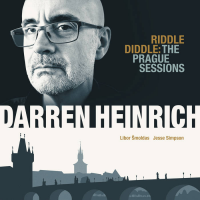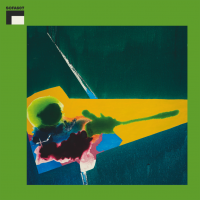Home » Jazz Articles » Album Review » Cecil Taylor: Mixed to Unit Structures Revisited
Cecil Taylor: Mixed to Unit Structures Revisited
"This album really opened me up to hearing music outside the parametres of time," said Hutchings. "I remember listening to it at first and not understanding anything about it. The first point of not understanding was how to relate to time. You don't realize how much your relationship to time depends on knowing how events are going to be placed within it. Like in general in jazz you know that there is going to be some kind of climax point, some kind of tension and release. Whereas this album, it was all tension, or all release, so it was kind of disorientating. I would close my eyes and listen and I wouldn't know whether I was at the beginning, the end or the middle of the music, just that I was in a timespace close to infinity."
The key to understanding the album, Hutchings went on to realise, was not to approach listening to it as a cognitive experience, but rather to listen to it emotionally, to feel it and to surrender to it. Only then did comprehension follow, and it was non-verbal, a Zen-like flash. The same is pretty much the case when it comes to listening to any Taylor album, including Mixed To Unit Structures Revisited. Part of the ezz-thetics label's Revisited series of remastered avant-garde classics from the 1960s, the disc brings together two albums: Into The Hot (Impulse, 1962) and Unit Structures (Blue Note, 1966).
Historical detour: Into The Hot was released under Gil Evans' name. Impulse had expected it to be the follow-up to Evans' 1961 debut for the label, Out Of The Cool, and had prepared front cover artwork accordingly in advance of the recording session. But for reasons which remain unclear, Evans chose to approach the project as a contractual obligation. Instead of recording any music himself, he took on the role of A&R person and gave half the album to Taylor and half to trumpeter and arranger John Carisi. The album was recorded in autumn 1961, when Impulse's head honcho, Creed Taylor, was already halfway out of the door en route to helming Verve, and his successor, Bob Thiele, had yet to get his feet fully under his desk. So gloriously unlikely is the juxtaposition of Cecil Taylor and Carisi that is hard not to imagine there was some mischief in Evans' intent, perhaps the settling of a score with, and the raising of a middle finger to, ABC-Paramount, the keepers of Impulse's purse strings. (This theory is given added weight by the fact that Evans did not simply give one side of the album to Taylor and the other side to Carisi. He shuffled their tracks up in the running order). Be that as it may, Into The Hot slipped through the corporate net and Evans' Out Of The Cool sequel proved to be The Individualism Of Gil Evans, produced by Creed Taylor for Verve in 1964. The three Cecil Taylor tracks on Into The Hot were in 1998 repackaged with some 1966 recordings by trombonist Roswell Rudd and reissued by Impulse as Mixed. End of historical detour.
The three tracks from Into The Hot are the openers on Mixed To Unit Structures Revisited. In 1961, Taylor's style, though already individual, was some distance from being fully formed. But the sublime "Mixed," at just short of thirteen minutes the longest of the three tracks, is getting there. Roswell Rudd and trumpeter Ted Curson turn the quintet into a sextet and the dense ensemble passages are signature Taylor, as is his warp-speed pianism and the solo by his longtime alto saxophonist Jimmy Lyons. Tenor saxophonist Archie Shepp, still at the start of his recording career but already a seasoned Taylor sideperson, also kicks it out. Unit Structures, recorded five years later, is Taylor in full effect. Shepp had gone his own way, Lyons was joined by second saxophonist Makanda Ken McIntyre, who doubled on bass clarinet, Eddie Gale Stevens Jr. replaced Curson, Henry Grimes was joined by second bassist Alan Silva, and Andrew Cyrille has replaced Sunny Murray on drums. This was classic mature Taylor and, although some people give an edge to Conquistador! (Blue Note, 1966), made with more or less the same lineup five months later, Unit Structures deserves to be in any serious jazz collection. The ezz-thetics remaster of Rudy Van Gelder's original recording is every bit as top-drawer as we have come to expect from the label.
Listening to this exalted music in 2021, one is struck by how radical and out there it still sounds. Almost uniquely among the avant garde which emerged in the 1960s, Taylor remains off planet; even Albert Ayler has to some extent become accepted within the mainstream of the jazz tradition (well, nearly). But Taylor's style is so totally sui generis that listening to him remains an invigorating shock to the system. It also demonstrates how inadequate the term "free jazz" is when applied to Taylor. Conservatoire trained long before that became commonplace in jazz, his minutely detailed, meticulously thought through and rigorously disciplined music shines like a beacon of principled individuality in 2021 as much as it did when it was first created. Magic.
Track Listing
Pots; Bulbs; Mixed; Steps; Enter, Evening (Soft Line Structure); Unit/Structure / As Of A Now / Section; Tales (8 Whisps).
Personnel
Cecil Taylor
pianoJimmy Lyons
saxophone, altoArchie Shepp
saxophone, tenorHenry Grimes
bass, acousticSunny Murray
drumsMakanda Ken McIntyre
saxophoneEddie Gale
trumpetAlan Silva
bass, acousticAndrew Cyrille
drumsAdditional Instrumentation
Cecil Taylor: piano; Jimmy Lyons: alto saxophone; Archie Shepp: tenor saxophone (1-3); Ken McIntyre: bass clarinet (4-7); Ted Curson: trumpet (3); Eddie Gale Stevens Jr.: trumpet (4-7); Roswell Rudd: trombone (3); Henry Grimes: double bass; Alan Silva: double bass (4-7); Sunny Murray: drums (1-3); Andrew Cyrille: drums (4-7).
Album information
Title: Mixed to Unit Structures Revisited | Year Released: 2021 | Record Label: Ezz-thetics
Tags
PREVIOUS / NEXT
Support All About Jazz
 All About Jazz has been a pillar of jazz since 1995, championing it as an art form and, more importantly, supporting the musicians who make it. Our enduring commitment has made "AAJ" one of the most culturally important websites of its kind, read by hundreds of thousands of fans, musicians and industry figures every month.
All About Jazz has been a pillar of jazz since 1995, championing it as an art form and, more importantly, supporting the musicians who make it. Our enduring commitment has made "AAJ" one of the most culturally important websites of its kind, read by hundreds of thousands of fans, musicians and industry figures every month.




























